Related Research Articles

The Scottish Deerhound, or simply the Deerhound, is a large breed of sighthound, once bred to hunt the red deer by coursing. In outward appearance, the Scottish Deerhound is similar to the Greyhound, but larger and more heavily boned with a rough-coat.
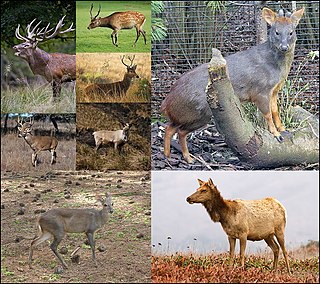
Deer or true deer are hoofed ruminant mammals forming the family Cervidae. The two main groups of deer are the Cervinae, including muntjac, elk (wapiti), red deer, and fallow deer; and the Capreolinae, including reindeer (caribou), white-tailed deer, roe deer, and moose. Male deer of all species, as well as female reindeer, grow and shed new antlers each year. In this, they differ from permanently horned antelope, which are part of a different family (Bovidae) within the same order of even-toed ungulates (Artiodactyla).

The sika deer, also known as the Northernspotted deer or the Japanese deer, is a species of deer native to much of East Asia and introduced to other parts of the world. Previously found from northern Vietnam in the south to the Russian Far East in the north, it is now uncommon except in Japan, where the species is overabundant.

Deer have significant roles in the mythology of various peoples located all over the world, such as object of worship, the incarnation of deities, the object of heroic quests and deeds, or as magical disguise or enchantment/curse for princesses and princes in many folk and fairy tales.
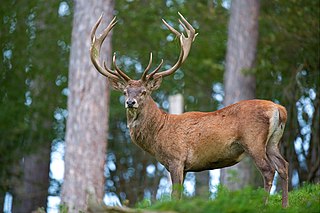
The red deer is one of the largest deer species. A male red deer is called a stag or hart, and a female is called a hind. The red deer inhabits most of Europe, the Caucasus Mountains region, Anatolia, Iran, and parts of western Asia. It also inhabits the Atlas Mountains of Northern Africa; its early ancestors are thought to have crossed over to Morocco, then to Algeria, Libya and Tunisia via the Strait of Gibraltar, becoming the only species of true deer (Cervidae) to inhabit Africa. Red deer have been introduced to other areas, including Australia, New Zealand, the United States, Canada, Peru, Uruguay, Chile and Argentina. In many parts of the world, the meat (venison) from red deer is used as a food source.

The sambar is a large deer native to the Indian subcontinent, South China and Southeast Asia that is listed as a vulnerable species on the IUCN Red List since 2008. Populations have declined substantially due to severe hunting, local insurgency, and industrial exploitation of habitat.
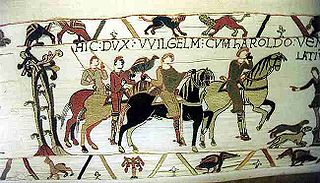
Throughout Western Europe in the Middle Ages, humans hunted wild animals. While game was at times an important source of food, it was rarely the principal source of nutrition. All classes engaged in hunting, but by the High Middle Ages, the necessity of hunting was transformed into a stylized pastime of the aristocracy. More than a pastime, it was an important arena for social interaction, essential training for war, and a privilege and measurement of nobility.
Charles William George St. John, English naturalist and sportsman, son of General the Hon. Frederick St John, second son of Frederick St John, 2nd Viscount Bolingbroke, was born on 3 December 1809 at Chailey, Sussex.

Gillie or ghillie is an ancient Gaelic term for a person who acts as a servant or attendant on a fishing, hunting, deer stalking or hawking expedition, primarily in the Scottish Highlands or on a river such as the River Spey. In origin it referred especially to someone who attended on his male employer or guests.

Deer hunting is hunting for deer for meat and sport, an activity which dates back tens of thousands of years. Venison, the name for deer meat, is a nutritious and natural food source of animal protein that can be obtained through deer hunting. There are many different types of deer around the world that are hunted for their meat. For sport, often hunters try to kill deer with the largest and most antlers to score them using inches. There are two different categories of antlers. They are typical and nontypical. They measure tine length, beam length, and beam mass by each tine. They will add all these measurements up to get a score. This score is the score without deductions. Deductions occur when the opposite tine is not the same length as it is opposite. That score is the deducted score.
Ledgowan Forest is a deer forest in the Scottish North-West Highlands. It stands in Wester Ross to the southwest of Achnasheen. Ledgowan Forest is the location of Carron Bog, the starting point of the River Carron.
The Lloyd Rifle was the 1950s brainchild of English deer-stalker, rifleman, metallurgist and engineer David Llewellyn Lloyd. His objective was to create a high-quality, scope-sighted, magazine-fed sporting rifle capable of dependably high accuracy at long ranges, of retaining its zero despite rough handling, and of firing modern high-intensity, flat shooting cartridges such as the .244 H&H Magnum and the .264 Winchester Magnum.

The deer forest is a sporting estate which is kept and managed largely or solely for the purposes of maintaining a resident population of red deer for sporting purposes. It is an institution and phenomenon peculiar to the Highlands of Scotland.
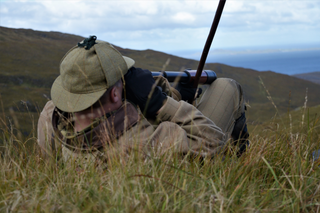
Deer stalking, or simply stalking, is a British term for the stealthy pursuit of deer on foot with the intention of hunting for meat, for leisure/trophy, or to control their numbers. As part of wildlife management, just as with rabbiting and boar hunting, the aim of deer stalking is to help reduce crop damage and obtain venison. Also, as with other types of hunting, deer stalking has long been considered a pastime sport.

A white stag is a white-colored red deer, wapiti, sika deer, chital, fallow deer, roe deer, white-tailed deer, black-tailed deer, reindeer, moose, or rusa, explained by a condition known as leucism that causes its hair and skin to lose its natural colour. The white deer has played a prominent role in many cultures' mythology.
Romania has a long history of hunting and remains a remarkable hunting destination, drawing many hunters because of its large numbers of brown bears, wolves, wild boars, red deer, and chamois. The concentration of brown bears in the Carpathian Mountains of central Romania is largest in the world and contains half of all Europe's population, except Russia.

A hart is a male red deer, synonymous with stag and used in contrast to the female hind; its use may now be considered mostly poetic or archaic. The word comes from Middle English hert, from Old English heorot; compare Frisian hart, Dutch hert, German Hirsch, and Swedish, Norwegian, and Danish hjort, all meaning "deer". Heorot is given as the name of Hrothgar's mead hall in the Old English epic Beowulf.
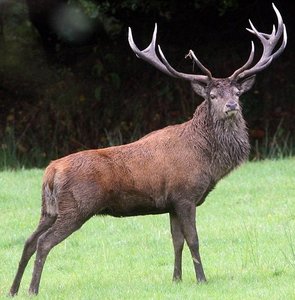
The Emperor of Exmoor, a red stag, was reportedly killed in October 2010. Its weight has been estimated as over 300 pounds (136 kg) and its height at 9 feet (2.7 m). Red deer on Exmoor National Park are larger than red deer in Scotland owing to their diet.
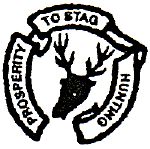
The red deer of Exmoor have been hunted since Norman times, when Exmoor was declared a Royal Forest. Collyns stated the earliest record of a pack of Staghounds on Exmoor was 1598. In 1803, the "North Devon Staghounds" became a subscription pack. In 1824/5 30 couples of hounds, the last of the true staghounds, were sold to a baron in Germany. Today, the Devon and Somerset is one of three staghounds packs in the UK, the others being the Quantock Staghounds and the Tiverton Staghounds. All packs hunt within Devon and Somerset. The Chairman as of 2016 is Tom Yandle, who was previously High Sheriff of Somerset in 1999.
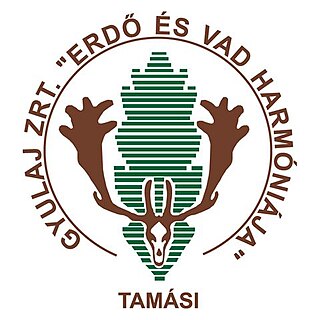
One of Hungary's 22 state owned forestry and hunting companies is Gyulaj Forestry and Hunting Private Limited Company. Its online marketing brand name is Gyulaj Hunting Hungary. Besides forest management one of its main business activities is big game management carried out in professional and traditional near- nature way. Its game management branch activities include receiving international hunting clients for purpose of hunting for local big game species. Its business premises are located in Tamási, South- West Hungary in Tolna County. Among the Hungarian state-owned forestries Gyulaj Plc is the leader by its highest rate of incomings from hunting section compared to the total annual incomings of the company. By this performance Gyulaj Forestry and Hunting Plc is a key player of the Hungarian big games management and hunting. Its legal predecessors and different hunting grounds look back at a rich hunting history and performance: a heritage that has been kept alive until today. Gyulaj Forestry and Hunting Plc has been operating in the legal form of a private limited company since November 3, 2005. With its center in Tamási it presently does forest management on nearly 23,500 hectares state forestland and quality game management on nearly 30,000 hectares in South-West Hungary.
References
- ↑ Watkins, M.G. (2004) 'St John, Charles George William (1809–1856)', Oxford Dictionary of National Biography. Oxford, UK: Oxford University Press; online edn, accessed 11 May 2020.
- 1 2 3 4 5 6 7 8 9 St John, Charles (1846). "The Muckle Hart of Benmore". Short Sketches of the Wild Sports and Natural History of the Highlands. London: John Murray. pp. 203–213.
- ↑ Edwards & Wallace 1927 , p. vi
- ↑ "Days and Nights of Salmon Fishing in the Tweed..." The Quarterly Review . 77 (153): 69–103. December 1845.
- ↑ Rutland, R. B. (1976). "Some Notes on the Highland Setting of Clough's "Bothie"". Victorian Poetry. 14 (2): 125–133. ISSN 0042-5206. JSTOR 40002379.
Much of the article, ostensibly a review of William Scrope's Days and Nights of Salmon Fishing in the Tweed (London, 1843), is taken up by an account of the stalking of the 'Muckle Hart of Benmore,' which Innes drew from notes by the sportsman-naturalist, Charles St. John.
- ↑ See, for example:
- St John, Charles (1847) ‘The Muckle Hart of Benmore’, Sydney Chronicle (New South Wales), 19 October 1847. https://trove.nla.gov.au/newspaper/article/31753883
- Chalmers, Patrick R. (1931). Mine Eyes To The Hills. London: A&C Black, Ltd. (dedicated to the Muckle Hart)
- Buchan, John (1921). Great Hours in Sport. London: Thomas Nelson and Sons, Limited. pp. 55–70.
- BB (Denys Watkins-Pitchford) (1994) The Shooting Man’s Bedside Book. Cambridge, UK: White Lion Books, pp. 138–148.
- Camp, Raymond R. (1961) Hunting Trails: A Sportsman’s Treasury. New York: Appleton-Century-Crofts, Inc. pp. 483–491.
- McManus, Peter (2002) One Man’s Scotland. Burton-on-Trent, UK: MEP Publishing, pp. 131–139.
- Hart-Davis, Duff (1978) Monarchs of the Glen—a History of Deer-Stalking in the Scottish Highlands. London: Jonathan Cape.
- 1 2 3 4 Edwards & Wallace 1927 , p. 105.
- ↑ Von der Schulenberg, Fritz (1997). Balnagown: Ancestral Home of the Clan Ross : a Scottish Castle Through Five Centuries. Brompton. p. 78. ISBN 978-1-900055-07-9.
The romance of deerstalking was spread by such writers as Charles St John who in 1833 stalked the celebrated muckle hart of Benmore...
- ↑ Cameron, A.G. (1923) The Wild Red Deer of Scotland. Blackwood: London and Edinburgh
- ↑ Martin, Maureen M. (2009). The Mighty Scot: Nation, Gender, and the Nineteenth-Century Mystique of Scottish Masculinity. SUNY Press. p. 75. ISBN 978-0-7914-7730-4.
- ↑ Lorimer, Hayden (2000). "Guns, game and the grandee: the cultural politics of deerstalking in the Scottish Highlands". Ecumene. 7 (4): 417. doi:10.1177/096746080000700402. ISSN 0967-4608. JSTOR 44252163. S2CID 143864212.
- ↑ Whitehead, George Kenneth (1980). Hunting & Stalking Deer in Britain Through the Ages. B.T. Batsford. ISBN 978-0-7134-2083-8.